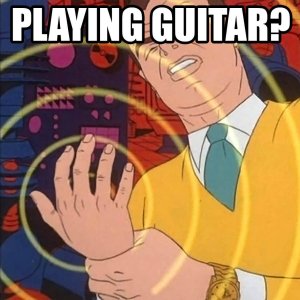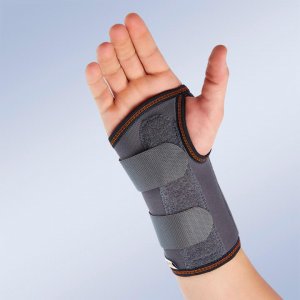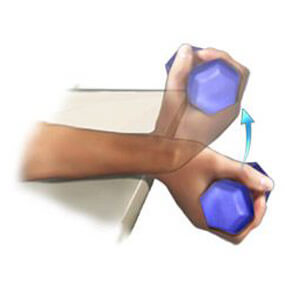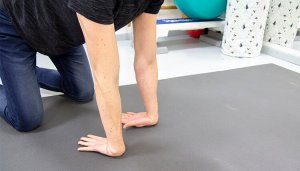Guitar wrist pain – What to do (and what not to)
Your hand or wrist hurts from playing guitar? Read this guide to avoid doing something you shouldn’t.

Written by Gergely Olah (aka Greg) | Movement specialist & guitarist
I help musicians get rid of playing-related injuries like wrist pain, tendonitis or carpal tunnel syndrome since 2017 with my 7 years of experience in the field of movement and health.
 So your wrist hurts when playing guitar?
So your wrist hurts when playing guitar?
You are not alone. Playing-related injuries appear to be just as “infectious” as COVID-19… Almost everyone gets them sooner or later.
Consequently, there’s loads of information available online about this topic of “guitar wrist pain” and similar issues, like how to get rid of…
- guitar tendonitis,
- tingling,
- numbness,
- stiffness,
- shoulder pain,
and a myriad of other symptoms.
The problem is that most of these tips come from guitar players, and not from health professionals. And the fact that let’s say, a few stretches are beneficial for one person, does not mean that they are beneficial to everyone else. (Or even if they are, other methods would offer much more reliable and faster results.)
Guitar wrist pain: general recommendations from the internet
First, let’s go over the usual recommendations that you can find on the internet (and whether they are reasonable).
Note: don’t follow these blindly.
1. Rest. Most of the time a full stop is recommended for at least 1-2 weeks until the pain goes away.
What’s wrong with it: Resting does nothing to solve the problem, it simply postpones it – if you start playing again, your symptoms will most likely return. And you will be wondering about whether you won 2 weeks, or lost 2 weeks. Probably the latter.
So here’s a better idea: reduce the amount of guitar practice you do by about 50%, and depending on the severity of your symptoms, skip the more technical stuff that strains your hands the most. Except for serious acute cases (like active tendonitis with swelling, or anything that causes strong, sharp pain), there’s no need to completely put down the guitar. We just need to back off a bit so that our body has a chance to regenerate (to make that happen you will need to do something, so read on).
 2. Ice. The good old icing can be very beneficial when our goal is to bring down inflammation (e.g. tendonitis), but people recommend it without even mentioning what is it good for…
2. Ice. The good old icing can be very beneficial when our goal is to bring down inflammation (e.g. tendonitis), but people recommend it without even mentioning what is it good for…
Ice, or more precisely cold, is a vasoconstrictor, in other words, it constricts the blood vessels. This forces out excess fluids from the area and can improve circulation to a degree. But excess fluids are only present when the area is inflamed! So there’s no point in icing if all you have is joint or muscle pain, or a nerve-related problem like tingling, or numbness, and so on (without inflammation).
 3. Splints and braces. These are recommended all the time to wear at night or even during the day to “compress and support the area and to minimize movement”. This might be necessary in sever cases and might help in the short-term, but still does nothing to solve the root issue. On the contrary… They restrict movement and thus decrease blood flow and lymph circulation, slowing down regeneration.
3. Splints and braces. These are recommended all the time to wear at night or even during the day to “compress and support the area and to minimize movement”. This might be necessary in sever cases and might help in the short-term, but still does nothing to solve the root issue. On the contrary… They restrict movement and thus decrease blood flow and lymph circulation, slowing down regeneration.
Plus it teaches the body that it can rely on something external for stability, instead of having to build internal stability with well-functioning muscles and joints. The result is even more instability and weakness that leads to even more problems in the long-term.
On the flip side, splints and braces are perfect for relearning to play without excessive wrist bending. Because if you developed wrist pain playing guitar, there’s a chance your wrist is bent too much when you play. Braces restrict wrist motion, forcing you to play with a straight wrist (this is not always feasible, though!).
 4. Wrist flexing exercises with a dumbbell. The logic here is as simple as “wrist hurts when playing guitar? It must be weak, let’s strengthen it”. Don’t get me wrong, developing strength in the right places can indeed decrease pain and solve even more complex musculoskeletal issues.
4. Wrist flexing exercises with a dumbbell. The logic here is as simple as “wrist hurts when playing guitar? It must be weak, let’s strengthen it”. Don’t get me wrong, developing strength in the right places can indeed decrease pain and solve even more complex musculoskeletal issues.
But the problem is that exercising the wrist in this way only works the muscles that are already too tense: the inner forearm muscles. Guitar playing overloads these muscles, called the “flexors” of the forearm because playing is mostly just finger curling with wrist bending.
If anything, you should do the opposite, strenghtening the extensor muscles on the “outside” of the forearm.
So my advice would be to skip this exercise for now (I’ll share my ideas in a minute)
5. Wrist stretches before playing guitar. This is another useless recommendation made by many guitarists. Anyone who studied anatomy, physiology or physical therapy knows that static stretching before exercise (read: playing guitar) rarely makes sense. The reason for this is that static stretching – when you simply hold a stretch for 15-30 seconds or longer – actually turns off muscles, decreasing their performance. As a “bonus” it also increases their chance of getting injured.
What you should do instead: warm up with movement, doing wrist circles while making a fist and then with straightened fingers, or basically any form of movement that moves the fingers, wrist, elbow and even the shoulder through their full range of motion. And then stretch AFTER guitar practice to get rid of the tension that may have accumulated during playing.
Of course, there’s some sound advice out there
1. Stop pushing down on the strings too hard. This one might be because of too high action on the guitar or simply bad playing habits, but this is 100% true. A light touch, just enough to make a note sound clean, is preferred.
 2. Posture. Another excellent point, I teach this all the time. Slouching, hunching over the guitar puts extreme stress on the spine, back and neck muscles overwork, nerves can become compressed which may lead to problems locally, or down the arm in the wrist or hand area. So strive for verticality – you should be as close to a neutral, normal standing / sitting posture as possible. Don’t let your guitar distort your body.
2. Posture. Another excellent point, I teach this all the time. Slouching, hunching over the guitar puts extreme stress on the spine, back and neck muscles overwork, nerves can become compressed which may lead to problems locally, or down the arm in the wrist or hand area. So strive for verticality – you should be as close to a neutral, normal standing / sitting posture as possible. Don’t let your guitar distort your body.
3. Straight wrist. Wrist bending was mentioned in this article earlier, and it’s very important indeed. Keeping any joint in a ‘far-from-neutral’ position for too long will cause muscle imbalances and joint problems down the road. Wrist bending (or wrist flexion, in other words) is necessary with certain wider chords and stuff, but unnecessary most of the time. So strive for a relatively straight wrist most of the time!
In conclusion, all of the above have their place, but recommending them to everyone without understanding the root causes is irresponsible. And of course, they are usually not enough to bring a significant, lasting improvement.
Understanding guitar wrist pain
First of all, we have to understand how playing the guitar causes wrist pain. This is a long story, but in a nutshell, the “root of all evil” is the repetitive, monotonous load inherent in guitar playing (and most other instruments).
This type of workload strains the muscles, tendons, joints, and fascia in one exact way over and over, and in time these tissues will begin to adapt to it. But since it’s a repetitive workload done in a narrow, restricted range of movement, the adaptation will cause imbalances between the muscles, instead of strengthening them all around.
This imbalance changes the way muscles pull on the bones. Some will pull too hard, some will pull too little, which will change the way bones move relative to each other, creating joint issues.
And let’s not forget about tendons: they connect muscles to bones. And if you pull on a tendon too strong for months or years, that tendon will have every right to become irritated and then inflamed. That is how guitar tendonitis is made.
So right now, we have a muscle imbalance that causes altered joint mechanics (leading to joint pain) and probably some irritated tendons. Now, add reduced mobility and micro-injuries to the mix, because tense, shortened muscles will resist movement, and that leads to micro-injuries deep in the tissues. This forms scar tissue over time, which is more pain sensitive and more inflexible, than regular tissue. And a low-grade inflammatory process always accompanies scar tissue formation, causing even more trouble…
It’s a negative spiral, exacerbated by further guitar practice.
And now that we know the basics, let’s see the action plan.
Here’s a better approach to solving guitar wrist pain
1. Reduce the amount of guitar practice by about 50% to get some leeway. No need for a complete stop unless your symptoms are severe.
 2. Reduce tension and increase circulation by massaging the affected area. Self-massage methods are the most practical as they can be done by ourselves. This step is the most important and in some cases, it might be enough on its own. Increased circulation brings faster regeneration, which is critical for the healing process!
2. Reduce tension and increase circulation by massaging the affected area. Self-massage methods are the most practical as they can be done by ourselves. This step is the most important and in some cases, it might be enough on its own. Increased circulation brings faster regeneration, which is critical for the healing process!
 3. Increase mobility, coordination and movement quality by doing exercises that move your joints in their full range of motion, and challenge your brain. The latter is especially important since a smarter brain controls the muscles better, which leads to safer and more efficient movement not only in guitar playing but in everything else, too.
3. Increase mobility, coordination and movement quality by doing exercises that move your joints in their full range of motion, and challenge your brain. The latter is especially important since a smarter brain controls the muscles better, which leads to safer and more efficient movement not only in guitar playing but in everything else, too.
And about the timing (in general): movement drills before playing, stretches after playing.
 4. Build resilience and strength the proper way to resist the negative effects of guitar playing outlined in the previous section. This step should come only when you are 95% free from pain, but it’s no less important, as it will “conserve” the progress you made and will make you pain-free for years.
4. Build resilience and strength the proper way to resist the negative effects of guitar playing outlined in the previous section. This step should come only when you are 95% free from pain, but it’s no less important, as it will “conserve” the progress you made and will make you pain-free for years.
5. Develop better body awareness so you can notice if you hold tension anywhere in your body while playing guitar (and then relax them, obviously).
Of course, there is more to it, but this approach (that is, by the way, the guitarstrength approach) will provide superior gains compared to the general recommendations you can find elsewhere on the internet.
With the help of this guide, you will be able to research further in this topic and create a routine for yourself.
But if you want a professional and effective solution to guitar wrist pain and most other playing-related injuries, then look no further.
The guitarstrength course is the best self-care method available to guitarists. It contains a well thought out system of techniques and exercises, along with countless tips about how to increase your playing performance. It’s hands-down the best investment for any musician, so check it out here:
Ready for the Intro Class?
Sign up to enroll in the 8-part Intro Class for free!
No spam, only useful info. You can always use the unsubscribe link included in the emails.
